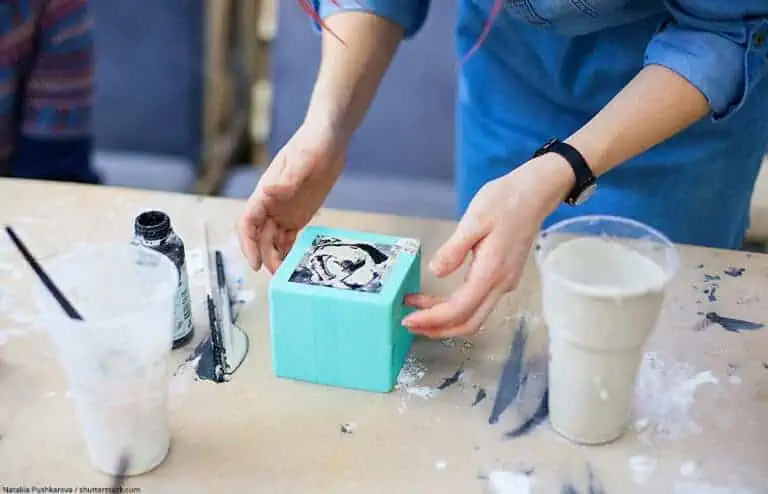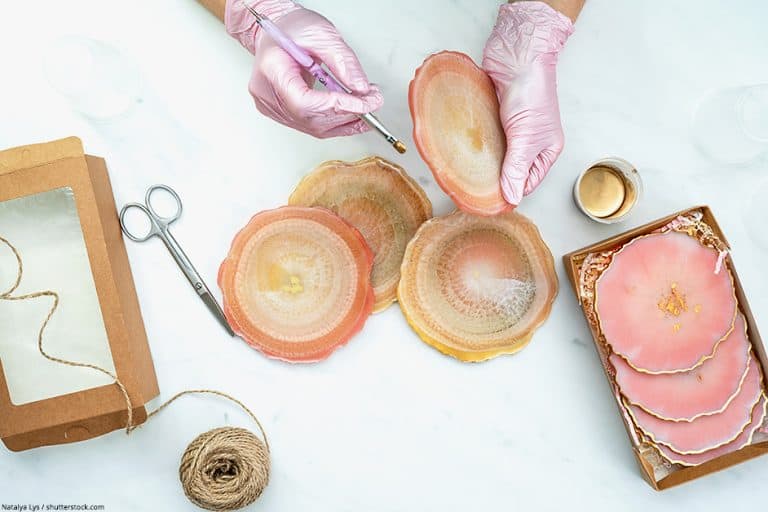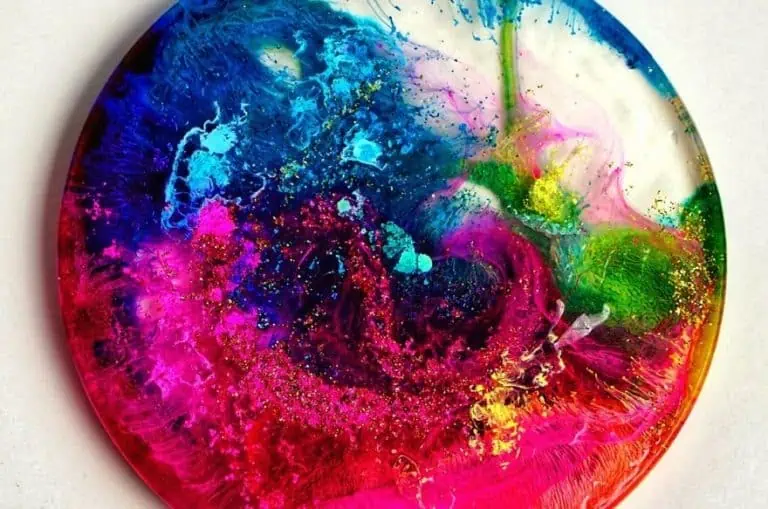Food Safe Epoxy – Helpful Guide and Overview of Approved Epoxy
This post may contain affiliate links. We may earn a small commission from purchases made through them, at no additional cost to you.
Working with epoxy resin offers a variety of advantages. The material is extremely flexible and can be used in many areas. However, the resin also has some disadvantages. The most important is the health aspects. In this guide, we inform you how food safe epoxy resin really is and what you should consider in this context.
Table of Contents
- 1 Food Safe Epoxy Resin with Test Seal
- 2 Only a few Epoxy Resin Products are Approved by the FDA
- 3 Best Food Grade Epoxy Available for Private Use
- 4 Food Grade Epoxy – what Exactly does that Mean?
- 5 Is Epoxy Food Safe?
- 6 What is BPA?
- 7 Get Food Safe Epoxy with Bisphenol A
- 8 How do I know how Harmless my Epoxy Resin is?
- 9 Safety first – Notes on Occupational Safety
- 10 Early Treatment of Skin Diseases
- 11 Conclusion
- 12 Frequently Asked Questions
Food Safe Epoxy Resin with Test Seal
If epoxy resin comes into contact with food or the skin over a longer period of time, it is important to clarify in advance how food-safe epoxy resin actually is. This is, for example, the case with
- Coatings of food tanks
- Molds used in the food industry (e.g. chocolate molds)
- Household articles, e.g. fruit bowls or cutting boards
- Furniture made of epoxy resin, especially epoxy resin tables
- Prostheses
- Orthoses
- Interior coatings of ponds
- Aquariums or terrariums
The good news first: the EU has its own seal of approval to indicate that the resin is food safe. There are specially developed products that bear this seal for our above-mentioned examples. However, every commercially available epoxy is actually food-safe and therefore harmless in case of short-term contact.
Tip: Only when resin is fully cured is it non-toxic or food safe. In the liquid state, epoxy resin and also the vapors produced are ALWAYS toxic! Therefore, you should take strict care that your skin does not come into contact with liquid resin.
Only a few Epoxy Resin Products are Approved by the FDA
Only a few years ago, the various European countries themselves determined which standards and country-specific certificates were necessary to be able to declare an epoxy resin as “food-safe”. After the introduction of the EU uniform guidelines, many manufacturers of casting resin refrained from having their products tested again in order to obtain the test seal. One reason for this is that obtaining the seal involves a great deal of effort. On the other hand, the approval is very expensive for the manufacturer. For this reason, there are only a few epoxy resins with this test seal on the market.
Let’s go through the best FDA approved epoxy products available in the market at the moment. The best brands to follow in this regard are Max CLR Epoxy and Art Resin. They are known to be used for getting those shiny coatings over your tabletops and counters. You can work with it for more than an hour, and it just takes a day to cure. Coming in varying sizes, these brands are also approved by the FDA and are a good choice to go ahead with.
The best feature is its consistency, where the very fluid nature of the resin fills even small gaps in your cast. This very much reduces the formation of air bubbles and makes the product look out of this world before it cures. Though one problematic result of this feature is that if the surface is not flat, it becomes very difficult to control its flow. It is approved for brief, direct use with food, making it a food-safe epoxy resin. It is deemed safe for countertops, bowls, and coatings for mugs. Though it is not as cost-effective as other epoxy resins, it has the huge advantage of keeping you safe over the other products on the market.
Best Food Grade Epoxy Available for Private Use
STONE Coat Food Safe Resin
The Stone Coat Art Coat Resin is designed to create art in all its forms. It’s a coating Resin with has a very high-quality yellowing filter. It’s officially FDA-approved to be a food-safe resin.
- Specifically designed for art projects, developed with professional artists
- Heat resistant, scratch resistant, food safe, maximum UV resistant, water resistant
- compatible with alcohol inks, acrylics, silicone oils, metallics, oil-based paint
- Extended working time, easy to clean
ZDSticky Epoxy Resin
The ZDSticky Epoxy Resin is produced in easy-to-use plastic bottles, which enables you to release the resin without any difficulty. This epoxy has a lot thicker consistency than many of the other epoxies here, mainly because it was intended for use in the jewelry industry. The resin would work great for this purpose; however, it is difficult to accomplish a perfect level surface. Due to its thicker consistency, it is also more difficult to get rid of air bubbles that form in the resin solution.
- Zdssticky resin selects German raw materials, safe and environmentally friendly
- It can be used to contact food after curing
- The special formulation we have developed has a lower bubble generation rate, allowing a thicker resin to be poured in a single pass
The brand boasts that its epoxy resin has a 24-hour curing time. However, many find that it takes a little longer to cure than that. Once it has properly dried, it will give you an amazingly smooth, crystal clear superior gloss finish. But to achieve this finish, it is a very frustrating process.
As far as food contact is concerned, ZDSticky resin is a perfect food-safe epoxy. The product carries an FDA approval with no VOC’s and has passed all the strict standards of the FDA. Therefore, it is an excellent choice for treating any wooden surfaces and countertops in your kitchen. Also, if you are into jewelry, this resin is a perfect choice.
MAX CLEAR GRADE Epoxy Resin System
This Two-Part Clear Epoxy Resin comes in a variety of sizes and is ideal for use on cutting boards, tabletops, and countertops. The resin gives you a 70-minute time period to work with and needs a minimum of 24 hours to completely cure.
Applying the epoxy is easy. Before the resin properly cures it has a low viscosity, which will enable you to fill up any gaps that may appear on the surface. This very same property will diminish the formation of air bubbles in the resin. However, there is a disadvantage, it makes it difficult to apply the resin on surfaces that are not flat or level. The run-off will form thicker deposits on the downside of the object you are coating.
- FDA Compliant Coating For Brief-Use Direct Food Contact
- Crystal Clear Coating For Wood And Other Porous Substrates
- High Gloss Sealant- Prevents Absorption, Impact Resistant, Durable Coating, Sanitizable
The manufactures instructions state that the MAX CLEAR GRADE epoxy resin carries an FDA approval for only brief direct contact with foodstuffs. However, there is no problem if you want to coat kitchen countertops you use for preparing your food. Many have also used it for coating ceramic mugs and bowls and have had no adverse effect. It is, however, more expensive than many of the other epoxy resins, but if it can protect your food from any contamination, it is well worth the price.
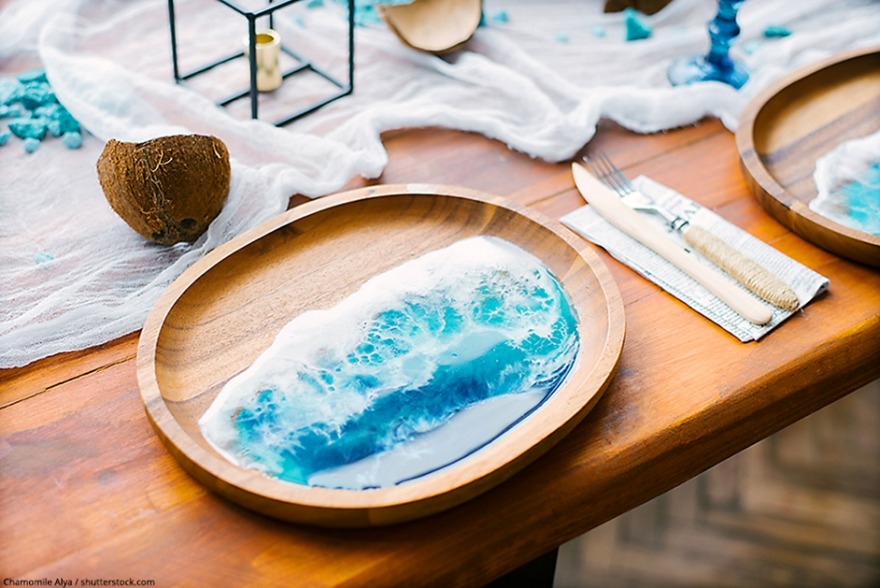
Food Grade Epoxy – what Exactly does that Mean?
There is no precise definition of what makes a material “food-safe”. However, some requirements must be met in any case. These include, for example, the food conformity requirements of the Food and Drug Administration (FDA), the Federal Office for Risk Assessment, and the requirements of the EU Regulation No. 10.2011.
In principle, a material is considered food safe if it can come into direct contact with food without posing any health risks. This means:
- The material does not release any taste or smell to the food
- Human health is not endangered if food is consumed after contact with the material
- The material releases no or very few free components into the food
The composition of the food, therefore, does not change by contact with the material
If in doubt, you should first check with the manufacturer to make sure it’s a food grade epoxy. It is also important to follow the mixing ratio recommended by the manufacturer carefully during processing in order to obtain the best possible quality of resin.
Is Epoxy Food Safe?
A general statement about whether epoxy resin is toxic or non-toxic cannot be made. This depends primarily on the chemical composition of the individual products.
However, this can vary depending on the intended use. One casting resin can therefore be more harmful to health than another. Nevertheless, it is always important to protect yourself as best as possible when working with the resin. Never touch the resin or hardener without protective gloves. You can protect yourself from the harmful vapors by wearing a breathing mask. It is also advisable to use safety glasses to prevent resin splashes from accidentally getting into your eyes.
Essentially, however, two basic statements can be made about the toxicity of epoxy resin:
- Liquid epoxy resin is always toxic
- The resin is non-toxic in the cured state
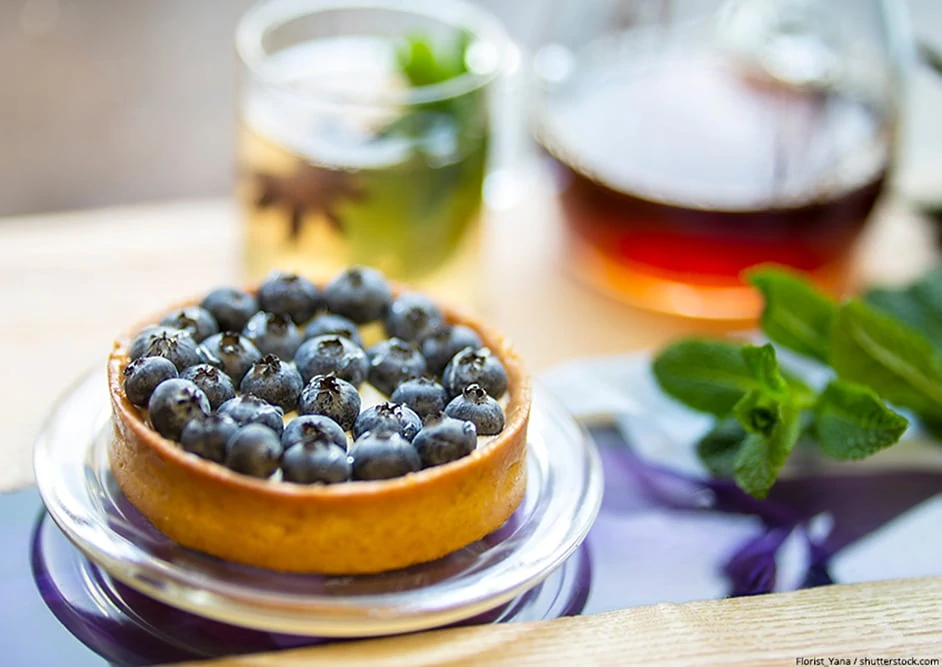
Inhalation of the vapors produced should be avoided as far as possible. However, you should know that direct skin contact with the resin is significantly more harmful to health than the vapors. Even though some casting resins are at least partially made from natural ingredients, even these are nevertheless toxic when they are in a liquid state. Caution is required especially with the following ingredients:
What is BPA?
To prepare an epoxy resin you need either Bisphenol A or Bisphenol F. The Bisphenol A or (BPA) is favored because of its curing properties. According to the FDA BPA is perfectly safe, even at low levels which can take place in certain foods. But BPA is still under ongoing assessment with the FDA.
Ever since the 1960s, Bisphenol A has been used in the manufacture of epoxy resins and also polycarbonate plastics. Reports from the Center for Disease Control show that they discovered high levels of BPA in over 90% of urine samples provided by over just over 2500 people in a range of age groups. This raises a certain amount of concern, as they are trying to limit the exposure to BPA because some studies have shown that it could be connected to certain health issues.
Should this worry you? This is why we have listed a few things below you can do to reduce your exposure to BPA.
- When metal containers are used for canning food or bottle caps, the manufactures use epoxy resin to coat the inside of the metal containers and bottle caps. The application of epoxy in these instances provide opportunities for the BPA to seep into the food, especially if the tin is heated. If this information scares you then we suggest you limit the number of canned foods, you consume or eliminate them.
- When plastic products are marked with a recycle code, make sure that the code is not a 3 or a 7, as these products may be manufactured with Bisphenol A. So, if the plastic products you want to purchase are not marked BPA-free, we suggest you avoid buying them.
- Try the keep any plastic that contains Bisphenol A clear from any heat source, as the heat may cause it to discharge. A practical example: do not to leave plastic water bottles that contain BPA in your car which stands in the sun, not even in the winter.
Precautions Regarding BPA that needs to be taken before Selecting Epoxy Resin
There has been a lot of speculation about using epoxy resin for items relating to food. But is it true? Well, there is a possibility that the chemical compound the resin is made of works well with food.
Specifically, the hardener should not contain any kind of amines as they can contaminate the food and make it fatal to consume. Though there are a lot of options besides the hardener itself, you should be careful while using it to prevent the formation of carcinogenic or mutagenic compounds. Since the use of such hardeners is already prohibited, to your relief, you have the option of choosing aliphatic and cycloaliphatic hardeners for food safe epoxy.
The main problem when it comes to epoxy is the presence of bisphenol of A-type and B-type. The presence of bisphenol A (BPA) in the epoxy is to increase the quality of curing. BPA is largely responsible for water pollution, as it is present in plastic compounds that are thrown into water bodies.
It has been found that BPA at minute levels can be used, and that it does not harm the body. Though many manufacturers have come forward in this initiative by announcing products that do not contain it, that is not vital considering normal human consumption of the chemical. The research has shown that almost all humans are exposed to it and consume it in some form, but how it affects the body in the long-term has not been confirmed yet.
The Food and Drug Administration has confirmed that BPA can be used at lower levels, but due to the skepticism and possibility of high toxicity, in the long run, it is not banned currently. There is still a lot of review and research which is being conducted in this regard. Previous research though has shown clearly that, since the start of using bisphenol A in plastics and resins, it is detectable in the human body.
Carbolic Acid / Phenol
Carbolic acid is used today in agriculture as a weed killer. In rare cases, it is also used as a disinfectant in low doses. In very high doses it is considered a nerve or cell poison and can cause chemical burns if it comes into contact with the skin.
Epichlorohydrin / Prepolymers and Diglycidyl Ether:
These substances are known to cause allergic reactions when in direct contact with the skin. Non-treatable contact eczema is also possible. The effect when these two substances are combined is still unknown. If one exposes oneself to a very high concentration of epichlorohydrin or diglycidyl ether over a longer period of time, it is suspected that they can be carcinogenic. Escaping vapors can also cause paralysis of the respiratory tract, irritation of the mucous membranes, or delirium. If one comes into contact with the toxic substances very frequently and over a longer period of time, nerve damage or kidney damage is also possible.
Tip: The products available on the market differ significantly in their toxicity. Products that are generally used in DIY and by craftsmen are less harmful than so-called industrial products. These often contain considerably more toxic substances because it is assumed that they are processed in factories in isolated rooms with an extraction mechanism. At this point it becomes clear that savings should not be made at the wrong end in the interests of health protection and quality. After all, the more harmful industrial goods are considerably cheaper than products for do-it-yourselfers.
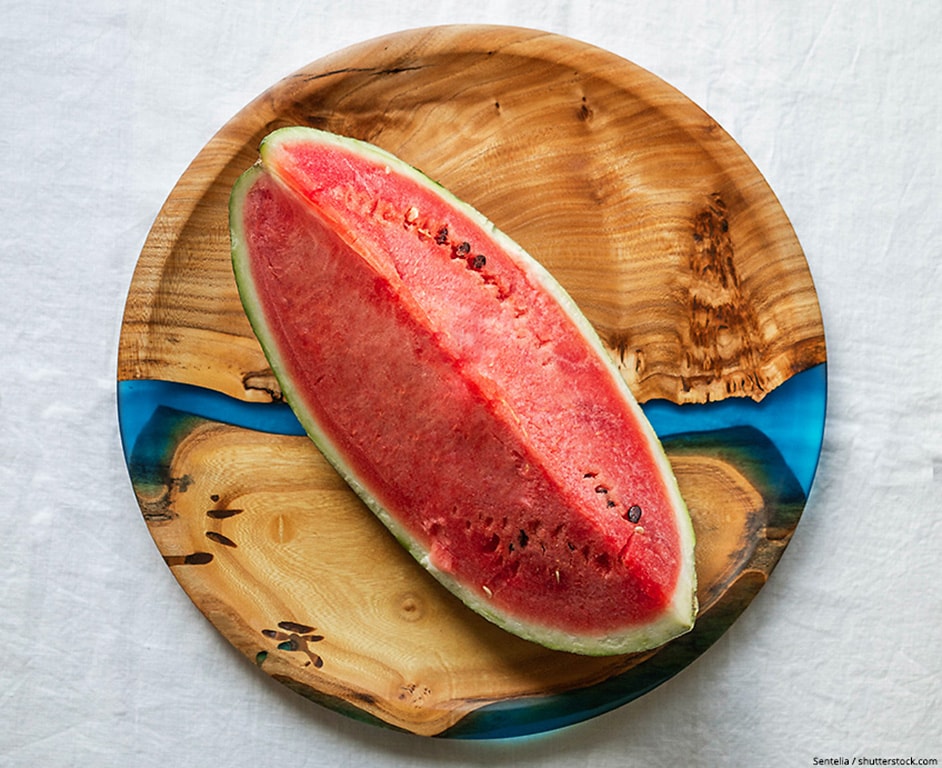
Get Food Safe Epoxy with Bisphenol A
However we see it, the fear of BPA’s effects on the body have put us in a constant state of conflict. Therefore, we have decided to move ahead in this section by believing that the health concerns have to be taken care of, and epoxy cannot be completely avoided. In this case, we recommend that you go for FDA-approved food-safe epoxy resins. Other than this, we are also helping out with some tips to help you keep safe from the effects of BPA in epoxy resin.
1. Keep the epoxy and food apart
BPA can contaminate food, and no matter whatever is proven, this fact cannot be changed. In this case, the best solution is that epoxy is used for applications where the container does not come in contact with food directly, and therefore, there is either little or no contact at all. When using epoxy to glue parts together, none of it should be exposed and should be covered via overlapping. It should be impossible for the food and epoxy to break through the barriers and find their way to each other. This completely depends on your design, so be careful when you are using them for food safe epoxy.
2. Not to be used for storage
If the containers are used for long-term storage, the BPA compound in the epoxy is bound to penetrate and spoil the food that is being stored. It is suggested that those food containers which are lined with epoxy should be used only for a short period. This way, the time they are in contact is reduced to a large extent, and you can save yourself from the possible contamination of your body. That is why the use of epoxy resin has not been eradicated when it comes to food. The best kind of use is with kitchen surfaces, but even for containers, using it temporarily is not a huge problem.
3. The epoxy mixture has to be measured and mixed with accuracy (1:1)
You should know that epoxy resin engages in a reaction of polymerization while you combine the two parts, and this can serve as a positive when it comes to reducing the effects of BPA. What is vital to know in this case is that the hardener and the epoxy both release their contaminants and reduce the chance of spoiling the food.
Artists or craftsmen who have been using epoxy must make a habit of measuring the two with high accuracy, and this can save them from the possible hazardous relationship between food and epoxy. You also save up on your ingredients this way and, by extension, also on your health. So try and be as accurate as you can.
4. Follow the instructions for curing
Generally, all manufacturers of epoxy always give specific instructions regarding the mixing and curing. Even though the hardening happens in less time, the complete procedure might take more than a day. Only when the epoxy is fully cured, should it be used. Otherwise, you create the possibility of the direct mixing of food and epoxy through leaching. So we suggest that it becomes a polymer completely before use.
5. Working with cured Epoxy
Do you want to grind, drill, or saw your epoxy coated product? Please do so in a well-ventilated space and use an A2 dust mask. This is important even if the cured epoxy is not dangerous anymore, it will emit fine toxic dust that can easily be inhaled.
How do I know how Harmless my Epoxy Resin is?
If you have any questions about food safety and the toxicity of the resin you use, it is best to contact the manufacturer directly. As a rule, the manufacturer provides the safety data sheets of its products on its website. There you can find out exactly how the ingredients of a particular casting resin are classified. The label for hazardous substances is just as informative. If in doubt, it is often worth calling the company itself or the customer hotline to clarify further questions.
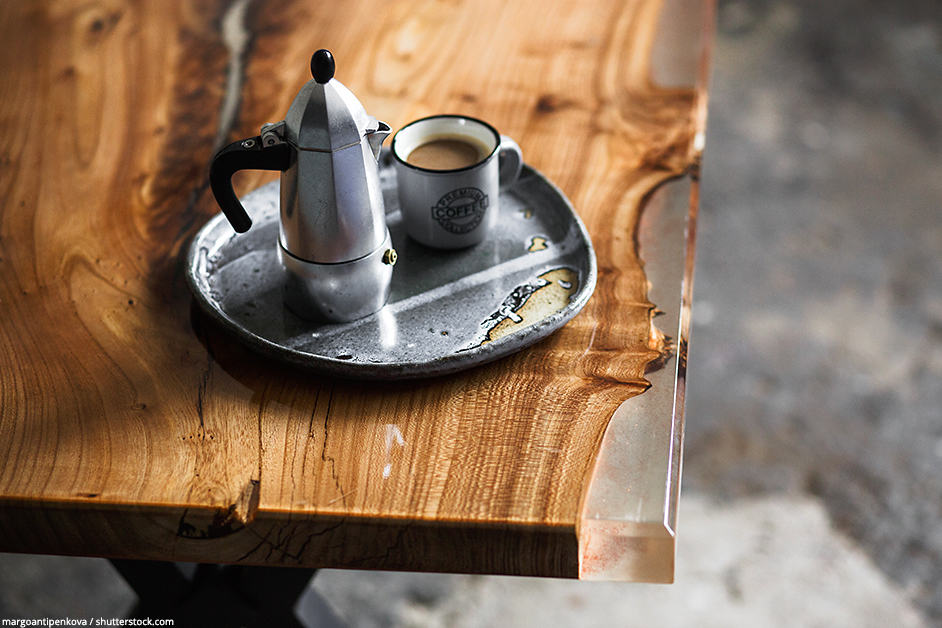
Safety first – Notes on Occupational Safety
- Resin and hardener contain toxic substances even if they have not yet been mixed together. Therefore you should always make sure that none of the substances comes into direct contact with the skin.
- After mixing the two components, a chemical reaction occurs, which produces toxic fumes. An important protective measure to avoid inhalation is the use of a respirator with an A2 filter. This will protect you from organic vapors and gases.
- You should use nitrile gloves to protect your hands. Latex gloves are not sufficient for working with epoxy resin.
- To protect your eyes from possible splashes, it is essential to wear protective goggles.
- A breathing mask should also be used when grinding, sawing, or drilling the cured resin afterward. Although the cast resin itself is non-toxic after curing, further processing may produce toxic dust which, like the vapors, should not be inhaled.
Tip: When working with epoxy resin, always make sure that the room in which you work is well ventilated. For your own safety, always use appropriate protective clothing even during further processing of the cured work piece.
Early Treatment of Skin Diseases
If you notice any changes in your skin shortly after working with epoxy resin, see a doctor as soon as possible. If possible, the first step should be to see a qualified dermatologist. If skin reactions caused by harmful substances in the resin are not treated, they often become chronic. Skin symptoms may also occur if epoxy resin vapors are inhaled, skin contact is not necessary.
If you follow the processing and safety instructions, epoxy resin is an incredibly versatile material.
Conclusion
The food-conscious world is extremely wary of what the body absorbs, and with the advancement of technology, the use of materials such as resins and its effects have also been taken into consideration. It cannot be ignored that the chemical contamination of the body is always a concern. That is why we came up with a set of precautions and tips that can save you from the constant struggle to choose between safety and practicality.
Therefore, after understanding the effects of bisphenol A and its role in epoxies, you can make an informed decision, and apply your knowledge in using food-safe epoxies.
Frequently Asked Questions
What Epoxy Resin Is Food Safe?
All epoxy resin products are completely food safe once cured. Epoxy resin creates an airtight layer of protection on virtually any surface it’s applied to, ensuring that your workpiece is not only protected from things like impact and abrasion, but is completely food safe too given that it has cured completely.
Is Epoxy Resin Safe for Cutting Boards?
Epoxy resin is safe for cutting boards and any other surface that comes into contact with food provided it has fully cured. Keep in mind that epoxy resin does have a certain level of toxicity while it is still wet, and you should wear personal protective wear if you are working with it.
How Do You Make Epoxy Resin Safe for Food?
Ordinary epoxy resin will be completely food safe once it has had a chance to cure completely. All that you need to do is mix and apply the epoxy resin to the surface of your choosing and allow it to dry for the manufacturer’s recommended time period.
Is There Food Safe Epoxy Resin?
Epoxy resin is completely neutral once it has had a chance to cure completely. You can use any epoxy resin that has been designed for sealing and/or surface protection to coat cutting boards, plates, or decorative tableware. There is no risk of food contamination once the epoxy has cured completely.
How Can You Tell If Epoxy Resin Is Food Safe?
The FDA guidelines for food-safe plastics states that any resin or resin plastic is completely safe for food contact as long as it is produced in accordance with their guidelines. Since all resins need to be produced according to these guidelines, all epoxy resin products produced in the US are food safe once they have cured completely.
Is Epoxy Resin Food Safe in the UK?
Epoxy resin is completely food safe given that it has had a chance to cure completely. High-grade epoxy resin is used in the production, storage, manufacturing, and distribution of foodstuffs not only in the UK but all over the world.
Sources:
Toxicology brochure from PlasticsEurope
In 2005, Charlene completed her wellness degrees in therapeutic aromatherapy and reflexology at the International School of Reflexology and Meridian Therapy. She worked for a company offering corporate wellness programs for several years before opening her own therapy practice. In 2015, she was asked by a digital marketer friend to join her company as a content creator, and it was here that she discovered her enthusiasm for writing. Since entering the world of content creation, she has gained a lot of experience over the years writing about various topics such as beauty, health, wellness, travel, crafting, and much more. Due to various circumstances, she had to give up her therapy practice and now works as a freelance writer. Since she is a very creative person and as a balance to writing likes to be active in various areas of art and crafts, the activity at acrylgiessen.com is perfect for her to contribute their knowledge and experience in various creative topics.
Learn more about Charlene Lewis and about us.






